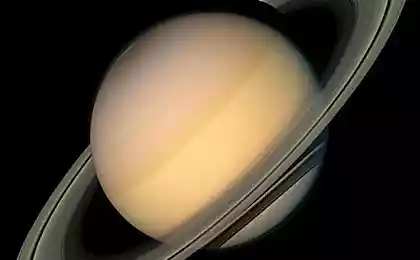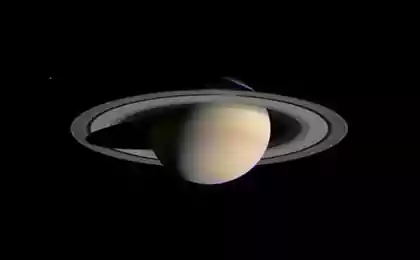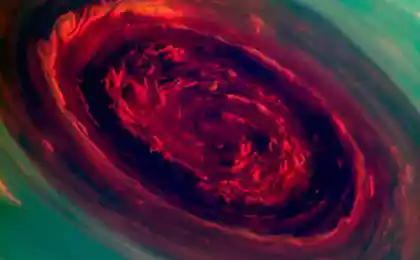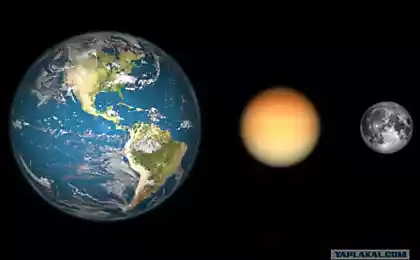939
Saturn and its satellites (30 photos)
The sixth planet in the solar system with its many satellites (at last count there are at least 62) can rightly be considered one of the most photogenic. This is facilitated by the presence of the beautiful ring of ice and dust from Saturn, fantastic water geysers at the south pole of Enceladus, a strange and mysterious atmosphere of Titan and many other unusual phenomena. Most succeeded in studying and photographing the Saturnian system NASA's "Cassini". This crown of engineering since 2004, has been working tirelessly in the orbit of Saturn, transmitting pictures and other scientific data.
Planet Saturn in natural color with a narrow strip of the shadows of the rings. Below left you can see the little dot, Mimas. The distance from the "Cassini" - 2, 7 million km.
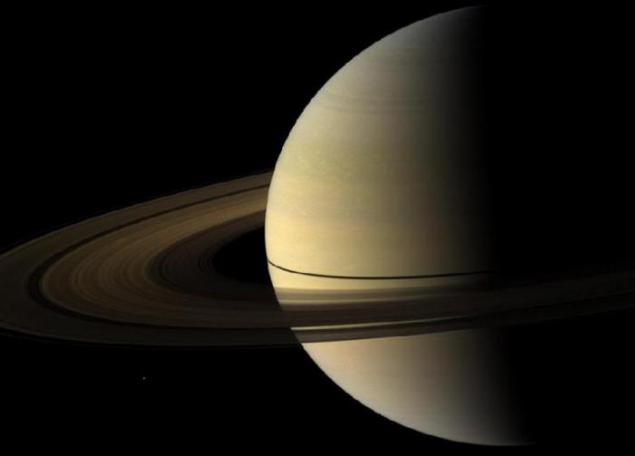
Tethys and its largest crater Odysseus hiding behind a huge Titan - the largest and most extraordinary Saturn's moon. The distance from the "Cassini" to Tethys - 2, 2 million km, to the Titan - 1 million km
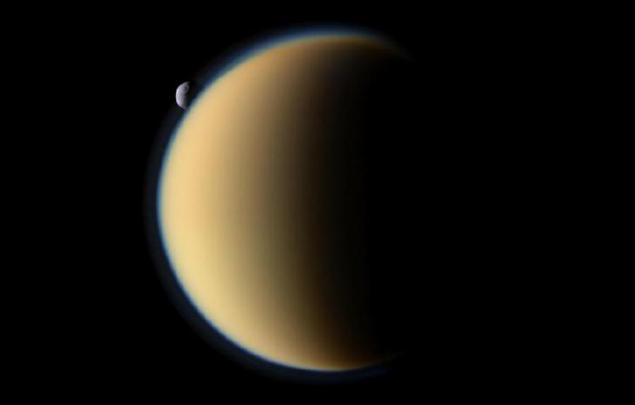
Tiny Mimas. The satellite of Saturn of 400 km in diameter is the smallest known celestial body that has a rounded shape due to its own gravity. The distance from the "Cassini" - 915 thous. Km
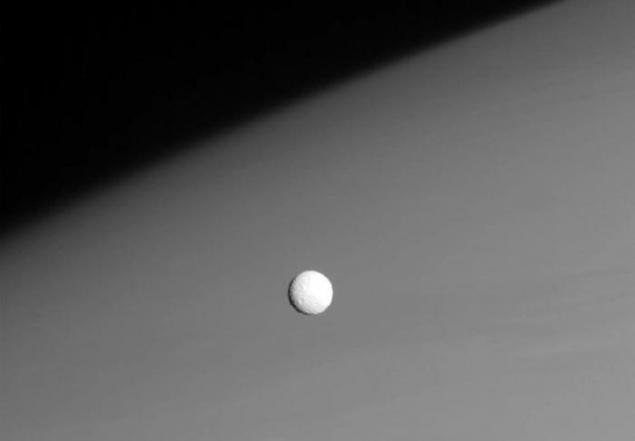
Mimas at a distance of 70 thousand. Km. In the background one can distinguish the edge of Saturn and the top layer of its atmosphere
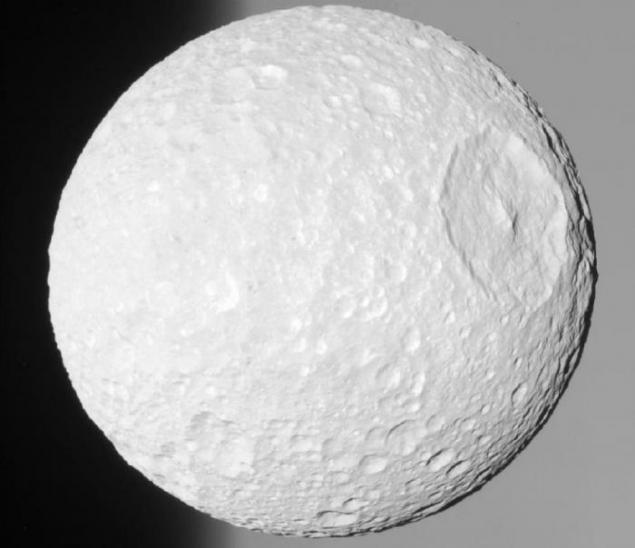
Herschel Crater width of 130 km on the surface of Mimas. The distance from the "Cassini" - 9 th. Km
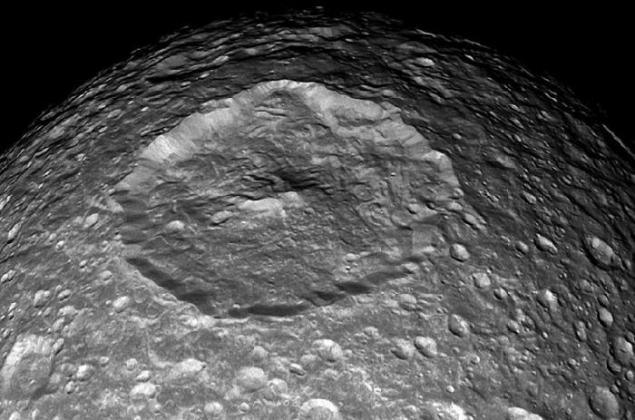
Unusual in shape Calypso - Trojan companion, traveling around the Tethys. Calypso's smooth surface is essentially free of craters, like most of the other moons of Saturn. The distance from the "Cassini" - 21 ths. Km
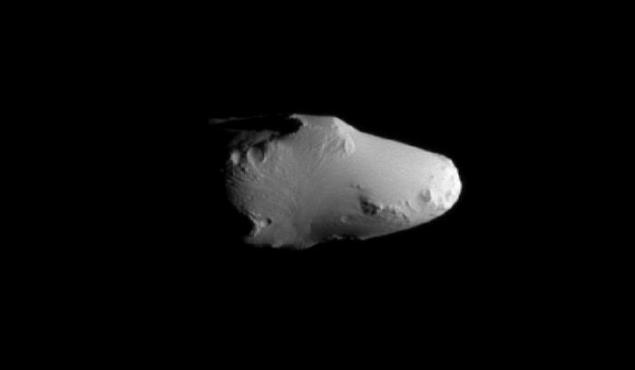
Enceladus - the sixth largest moon of Saturn. The distance from the "Cassini" - 200 thous. Km
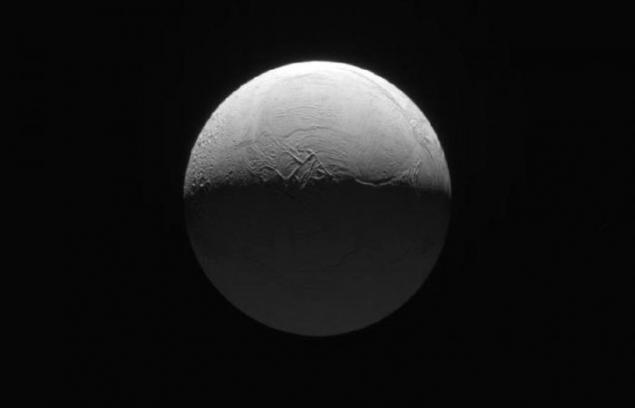
Water geysers at the south pole of Enceladus. The distance from the "Cassini" - 17 ths. Km
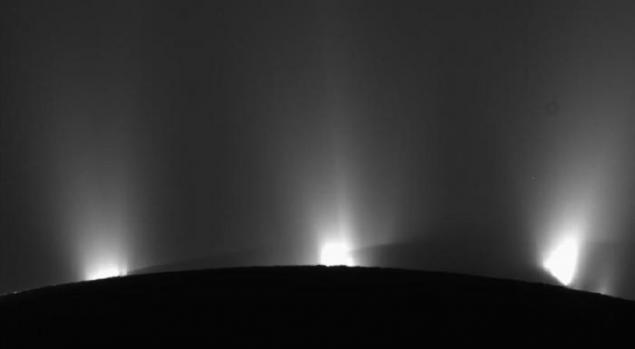
Another shot of ice geysers of Enceladus. Authentically kriovulkanicheskaya active satellite was confirmed in 2005 and to this day remains the subject of a thorough investigation. Initially formed from water vapor, these pillars also contain nitrogen, carbon dioxide, methane, ammonia, acetylene, propane, and hydrogen cyanide.
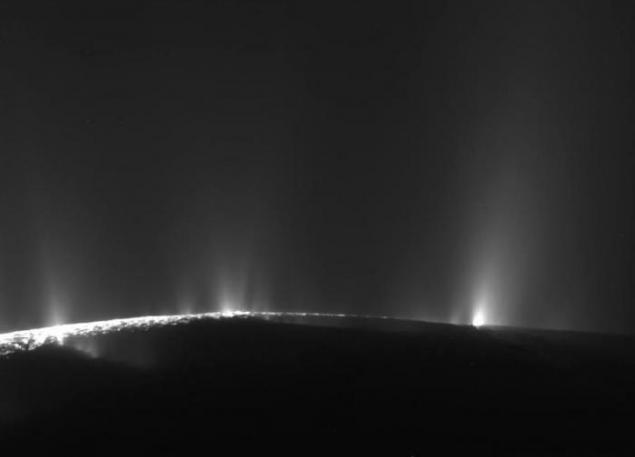
The surface of Enceladus, crisscrossed with cracks and ridges. The distance from the "Cassini" - 2 thous. Km
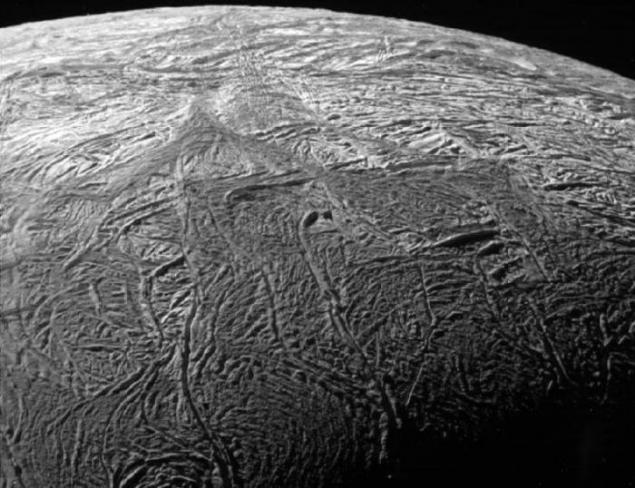
An approximate form of the surface of Enceladus. This area, known as Baghdad, is one of four so-called "tiger stripes" that cross the south pole of Enceladus. Their depth is 500 m, width - 2 km, and length - up to 130 of the surface of Enceladus km.Priblizhenny. This area, known as Baghdad, is one of four so-called "tiger stripes" that cross the south pole of Enceladus. Their depth is 500 m, width - 2 km, and length - up to 130 km.
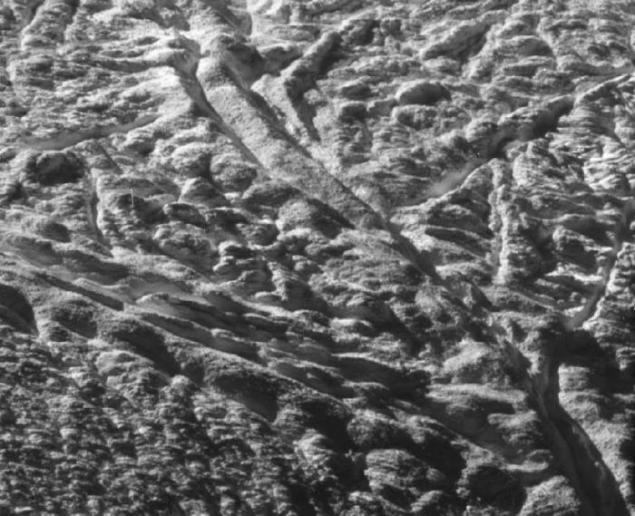
An even more detailed picture of "tiger stripes" on Enceladus Baghdad. Approximate distance from edge to edge image - 12 km, at this scale can be discerned even individual icy boulders
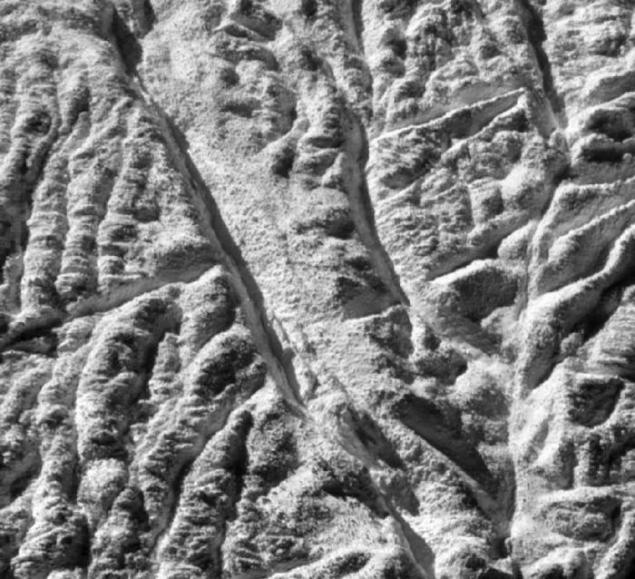
Enceladus continues to spew icy poles into space. It is believed that Enceladus geysers and it can be a major source of ice for the E ring of Saturn
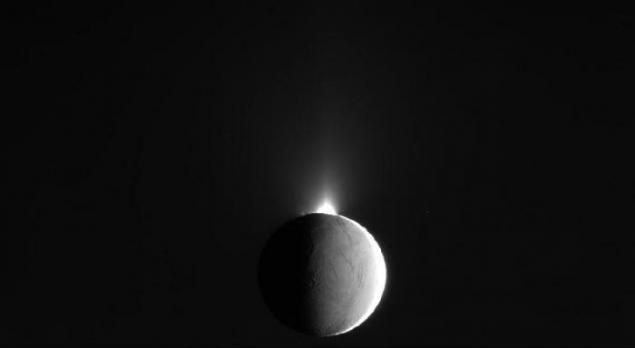
The small moon of Saturn Helen. Its average diameter of 32 km

The dark edge of Enceladus (in the foreground below), the Titan and Saturn's rings between two satellites
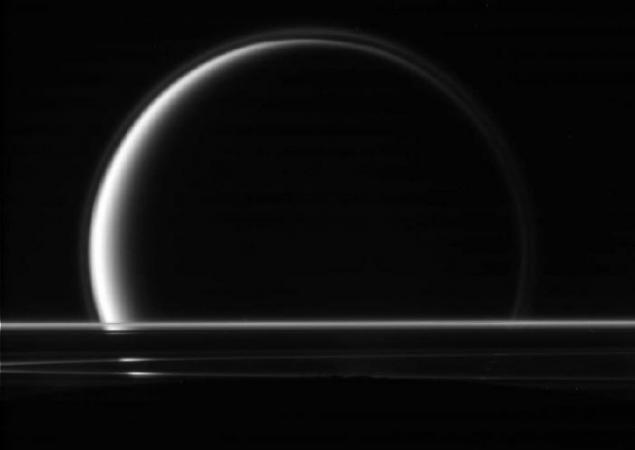
Tethys, a diameter of 1060 km. It is located in the orbital resonance with the Trojan satellites - Telesto and Calypso
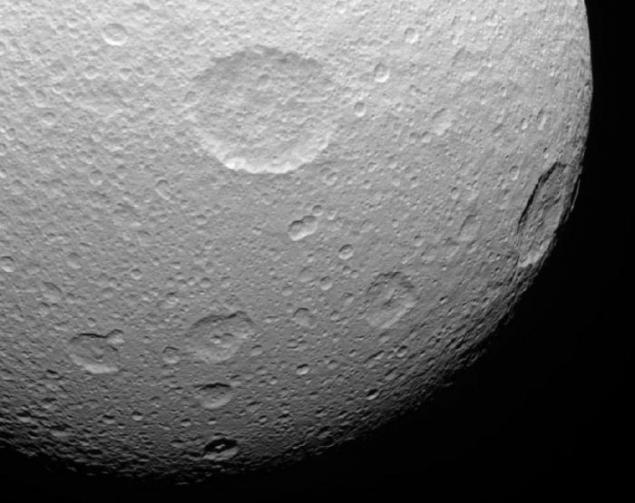
The craters on the surface of Prometheus, like holes in the potatoes. Prometheus also known as the "shepherd" of Saturn's F ring. The distance from the "Cassini" - 34 ths. Km
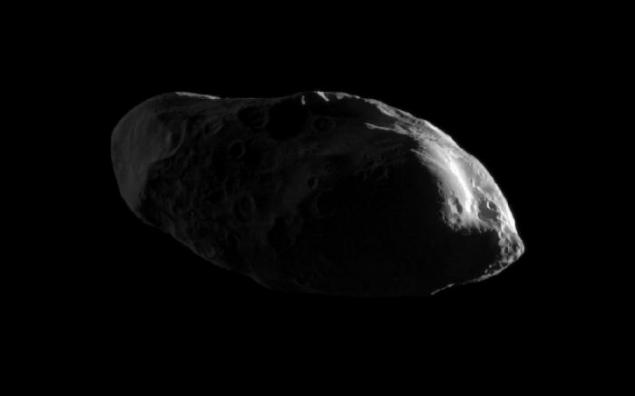
Rhea looms "close" with her twin Epimetheus against the backdrop of Saturn's rings. In fact, all the objects photos significantly distant from each other. The distance from the "Cassini" to Rhea - 1, 2 million km, to Epimetheus - 1, 6 million km
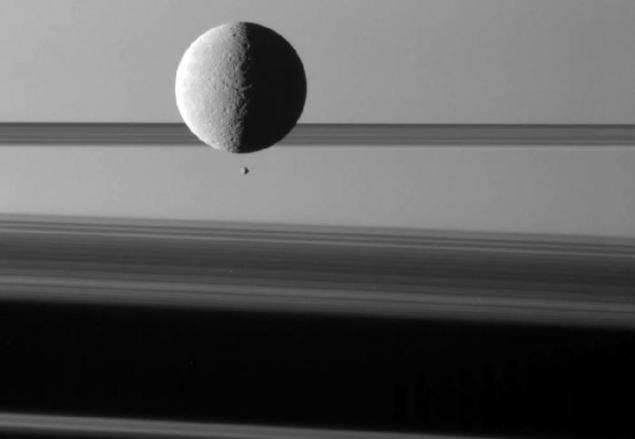
The dark side of Saturn and Enceladus in the background. Light passing through the atmosphere of Saturn, creates a bright arc (top to bottom), which is blocked (center) ice rings
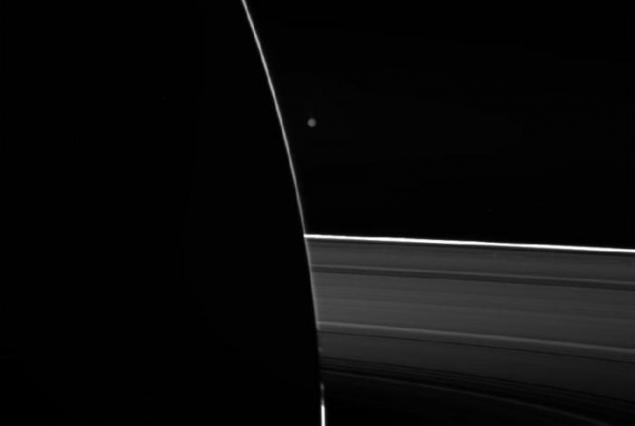
Clouds of Saturn's upper atmosphere. Bottom Right - a slice of satellite Helena

Reflection of sunlight in the water on Saturn's moon - Titan. Scientists have been able to agree on the location of the phenomenon - it happened on Kraken Mare, the largest hydrocarbon reservoir Titan area of about 400 sq. M. km
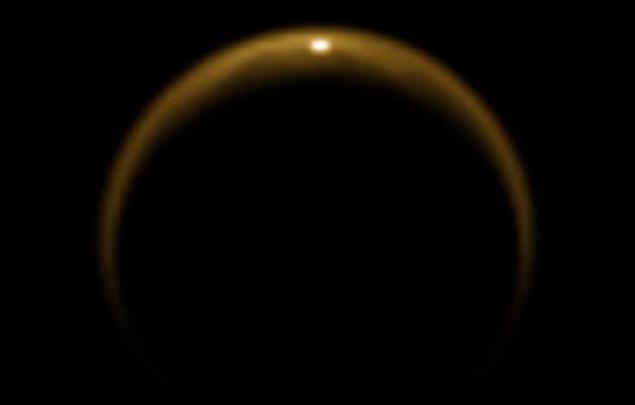
The shadow of Saturn's largest moon darkens to turn the giant planet. The distance from the "Cassini" - 2, 1 million km
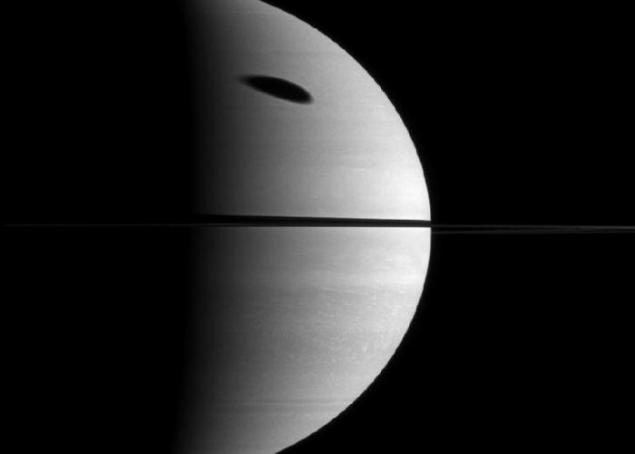
Saturn's rings, and partly closed the shadow of the planet, stand out from Saturn's largest moon - Titan. Below the center - Mimas.

The surface of Dione. Dion have strengths and weaknesses cratered area. Many of the most cratered areas are located on the trailing hemisphere of the satellite, whereas, according to estimates, the largest meteorite bombardment should be subject to the leading hemisphere. Perhaps once Dion has been deployed as a result of the impact of a large celestial body. The distance from the "Cassini" - 2, 5 thousand. Km.

Enceladus partially blocks "Cassini" view of the rings of Saturn

Saturn's moon Dione passes "by" Titan. The distance from the "Cassini" to Dione - 2, 2 million km, to the Titan - 3, 6 million km.

A large storm cloud in the northern latitudes of Saturn. The distance from the "Cassini" - 523 thous. Km
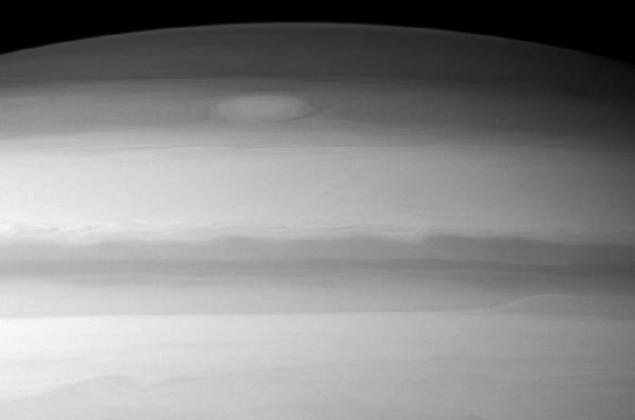
Prometheus (left) creates an elaborate patterns on the F ring of Saturn, while Daphnis (bottom right in the middle) ring A. alarmed

Golden "smoky" Titan's atmosphere and fog with a complex layered pattern, like a halo. It merged six shots - two for each color filter (red, blue, green). The distance from the "Cassini" - 145 thous. Km
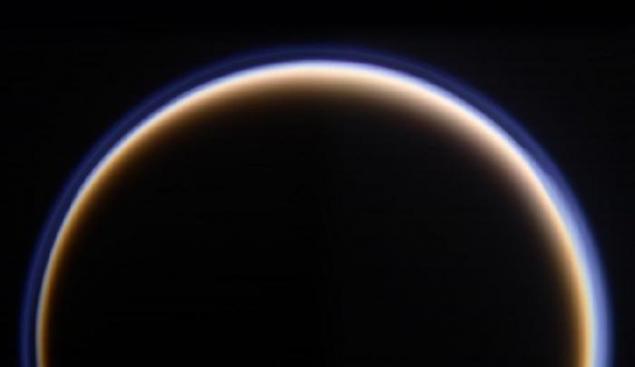
Just four of Saturn's moon in one frame: a huge Titan in the background, a little less of Dion, an even smaller Pandora (to the right of the Rings) and very tiny Ban, who hid in the Encke gap (left)

Planet Saturn in natural color with a narrow strip of the shadows of the rings. Below left you can see the little dot, Mimas. The distance from the "Cassini" - 2, 7 million km.

Tethys and its largest crater Odysseus hiding behind a huge Titan - the largest and most extraordinary Saturn's moon. The distance from the "Cassini" to Tethys - 2, 2 million km, to the Titan - 1 million km

Tiny Mimas. The satellite of Saturn of 400 km in diameter is the smallest known celestial body that has a rounded shape due to its own gravity. The distance from the "Cassini" - 915 thous. Km

Mimas at a distance of 70 thousand. Km. In the background one can distinguish the edge of Saturn and the top layer of its atmosphere

Herschel Crater width of 130 km on the surface of Mimas. The distance from the "Cassini" - 9 th. Km

Unusual in shape Calypso - Trojan companion, traveling around the Tethys. Calypso's smooth surface is essentially free of craters, like most of the other moons of Saturn. The distance from the "Cassini" - 21 ths. Km

Enceladus - the sixth largest moon of Saturn. The distance from the "Cassini" - 200 thous. Km

Water geysers at the south pole of Enceladus. The distance from the "Cassini" - 17 ths. Km

Another shot of ice geysers of Enceladus. Authentically kriovulkanicheskaya active satellite was confirmed in 2005 and to this day remains the subject of a thorough investigation. Initially formed from water vapor, these pillars also contain nitrogen, carbon dioxide, methane, ammonia, acetylene, propane, and hydrogen cyanide.

The surface of Enceladus, crisscrossed with cracks and ridges. The distance from the "Cassini" - 2 thous. Km

An approximate form of the surface of Enceladus. This area, known as Baghdad, is one of four so-called "tiger stripes" that cross the south pole of Enceladus. Their depth is 500 m, width - 2 km, and length - up to 130 of the surface of Enceladus km.Priblizhenny. This area, known as Baghdad, is one of four so-called "tiger stripes" that cross the south pole of Enceladus. Their depth is 500 m, width - 2 km, and length - up to 130 km.

An even more detailed picture of "tiger stripes" on Enceladus Baghdad. Approximate distance from edge to edge image - 12 km, at this scale can be discerned even individual icy boulders

Enceladus continues to spew icy poles into space. It is believed that Enceladus geysers and it can be a major source of ice for the E ring of Saturn

The small moon of Saturn Helen. Its average diameter of 32 km

The dark edge of Enceladus (in the foreground below), the Titan and Saturn's rings between two satellites

Tethys, a diameter of 1060 km. It is located in the orbital resonance with the Trojan satellites - Telesto and Calypso

The craters on the surface of Prometheus, like holes in the potatoes. Prometheus also known as the "shepherd" of Saturn's F ring. The distance from the "Cassini" - 34 ths. Km

Rhea looms "close" with her twin Epimetheus against the backdrop of Saturn's rings. In fact, all the objects photos significantly distant from each other. The distance from the "Cassini" to Rhea - 1, 2 million km, to Epimetheus - 1, 6 million km

The dark side of Saturn and Enceladus in the background. Light passing through the atmosphere of Saturn, creates a bright arc (top to bottom), which is blocked (center) ice rings

Clouds of Saturn's upper atmosphere. Bottom Right - a slice of satellite Helena

Reflection of sunlight in the water on Saturn's moon - Titan. Scientists have been able to agree on the location of the phenomenon - it happened on Kraken Mare, the largest hydrocarbon reservoir Titan area of about 400 sq. M. km

The shadow of Saturn's largest moon darkens to turn the giant planet. The distance from the "Cassini" - 2, 1 million km

Saturn's rings, and partly closed the shadow of the planet, stand out from Saturn's largest moon - Titan. Below the center - Mimas.

The surface of Dione. Dion have strengths and weaknesses cratered area. Many of the most cratered areas are located on the trailing hemisphere of the satellite, whereas, according to estimates, the largest meteorite bombardment should be subject to the leading hemisphere. Perhaps once Dion has been deployed as a result of the impact of a large celestial body. The distance from the "Cassini" - 2, 5 thousand. Km.

Enceladus partially blocks "Cassini" view of the rings of Saturn

Saturn's moon Dione passes "by" Titan. The distance from the "Cassini" to Dione - 2, 2 million km, to the Titan - 3, 6 million km.

A large storm cloud in the northern latitudes of Saturn. The distance from the "Cassini" - 523 thous. Km

Prometheus (left) creates an elaborate patterns on the F ring of Saturn, while Daphnis (bottom right in the middle) ring A. alarmed

Golden "smoky" Titan's atmosphere and fog with a complex layered pattern, like a halo. It merged six shots - two for each color filter (red, blue, green). The distance from the "Cassini" - 145 thous. Km

Just four of Saturn's moon in one frame: a huge Titan in the background, a little less of Dion, an even smaller Pandora (to the right of the Rings) and very tiny Ban, who hid in the Encke gap (left)




